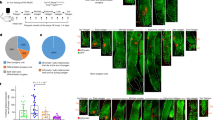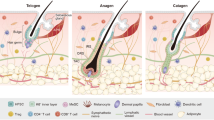Abstract
Hair graying is one of the prototypical signs of human aging. Maintenance of hair pigmentation is dependent on the presence and functionality of melanocytes, neural crest derived cells which synthesize pigment for growing hair. The melanocytes, themselves, are maintained by a small number of stem cells which reside in the bulge region of the hair follicle. The recent characterization of the melanocyte lineage during aging has significantly accelerated our understanding of how age-related changes in the melanocyte stem cell compartment contribute to hair graying. This review will discuss our current understanding of hair graying, drawing on evidence from human and mouse studies, and consider the contribution of melanocyte stem cells to this process. Furthermore, using the melanocyte lineage as an example, it will discuss common theories of tissue and stem cell aging.

Similar content being viewed by others
References
Allsopp, R. C., Morin, G. B., DePinho, R., Harley, C. B., & Weissman, I. L. (2003). Telomerase is required to slow telomere shortening and extend replicative lifespan of HSCs during serial transplantation. Blood, 102, 517–520.
Arck, P. C., Overall, R., Spatz, K., Liezman, C., Handjiski, B., Klapp, B. F., et al. (2006). Towards a “free radical theory of graying”: Melanocyte apoptosis in the aging human hair follicle is an indicator of oxidative stress induced tissue damage. FASEB Journal, 20, 1567–1569.
Bandyopadhyay, D., & Medrano, E. E. (2003). The emerging role of epigenetics in cellular and organismal aging. Experimental Gerontology, 38, 1299–1307.
Barsh, G. S. (1996). The genetics of pigmentation: From fancy genes to complex traits. Trends in Genetics, 12, 299–305.
Blackburn, E. H. (2001). Switching and signaling at the telomere. Cell, 106, 661–673.
Blanpain, C., Horsley, V., & Fuchs, E. (2007). Epithelial stem cells: Turning over new leaves. Cell, 128, 445–458.
Blanpain, C., Lowry, W. E., Geoghegan, A., Polak, L., & Fuchs, E. (2004). Self-renewal, multipotency, and the existence of two cell populations within an epithelial stem cell niche. Cell, 118, 635–648.
Botchkareva, N. V., Khlgatian, M., Longley, B. J., Botchkarev, V. A., & Gilchrest, B. A. (2001). SCF/c-kit signaling is required for cyclic regeneration of the hair pigmentation unit. FASEB Journal, 15, 645–658.
Cable, J., Jackson, I. J., & Steel, K. P. (1995). Mutations at the W locus affect survival of neural crest-derived melanocytes in the mouse. Mechanisms of Development, 50, 139–150.
Chang, S., Multani, A. S., Cabrera, N. G., Naylor, M. L., Laud, P., Lombard, D., et al. (2004). Essential role of limiting telomeres in the pathogenesis of Werner syndrome. Nature Genetics, 36, 877–882.
Chin, L., Artandi, S. E., Shen, Q., Tam, A., Lee, S. L., Gottlieb, G. J., et al. (1999). p53 Deficiency rescues the adverse effects of telomere loss and cooperates with telomere dysfunction to accelerate carcinogenesis. Cell, 97, 527–538.
Commo, S., Gaillard, O., & Bernard, B. A. (2004). Human hair greying is linked to a specific depletion of hair follicle melanocytes affecting both the bulb and the outer root sheath. British Journal of Dermatology, 150, 435–443.
Conboy, I. M., Conboy, M. J., Wagers, A. J., Girma, E. R., Weissman, I. L., & Rando, T. A. (2005). Rejuvenation of aged progenitor cells by exposure to a young systemic environment. Nature, 433, 760–764.
Conboy, I. M., & Rando, T. A. (2005). Aging, stem cells and tissue regeneration: Lessons from muscle. Cell Cycle, 4, 407–410.
d’Adda di Fagagna, F., Reaper, P. M., Clay-Farrace, L., Fiegler, H., Carr, P., Von Zglinicki, T., et al. (2003). A DNA damage checkpoint response in telomere-initiated senescence. Nature, 426, 194–198.
Globerson, A. (1999). Hematopoietic stem cells and aging. Experimental Gerontology, 34, 137–146.
Gosain, A., & DiPietro, L. A. (2004). Aging and wound healing. World Journal of Surgery, 28, 321–326.
Hemesath, T. J., Steingrimsson, E., McGill, G., Hansen, M. J., Vaught, J., Hodgkinson, C. A., et al. (1994). Microphthalmia, a critical factor in melanocyte development, defines a discrete transcription factor family. Genes & Development, 8, 2770–2780.
Johnson, R., & Jackson, I. J. (1992). Light is a dominant mouse mutation resulting in premature cell death. Nature Genetics, 1, 226–229.
Karlseder, J., Broccoli, D., Dai, Y., Hardy, S., & de Lange, T. (1999). p53-and ATM-dependent apoptosis induced by telomeres lacking TRF2. Science, 283, 1321–1325.
Kiger, A. A., Jones, D. L., Schulz, C., Rogers, M. B., & Fuller, M. T. (2001). Stem cell self-renewal specified by JAK-STAT activation in response to a support cell cue. Science, 294, 2542–2545.
Kunisada, T., Yoshida, H., Yamazaki, H., Miyamoto, A., Hemmi, H., Nishimura, E., et al. (1998). Transgene expression of steel factor in the basal layer of epidermis promotes survival, proliferation, differentiation and migration of melanocyte precursors. Development, 125, 2915–2923.
Kurita, K., Nishito, M., Shimogaki, H., Takada, K., Yamazaki, H., & Kunisada, T. (2005). Suppression of progressive loss of coat color in microphthalmia-vitiligo mutant mice. Journal of Investigative Dermatology, 125, 538–544.
Lamoreux, M. L., Boissy, R. E., Womack, J. E., & Nordlund, J. J. (1992). The Vit gene maps to the Mi (Microphthalmia) locus of the laboratory mouse. Journal of Heredity, 83, 435–439.
Lee, H. W., Blasco, M. A., Gottlieb, G. J., Horner, J. W., Greider, C. W., & DePinho, R. A. (1998). Essential role of mouse telomerase in highly proliferative organs. Nature, 392, 569–574.
Lerner, A. B., Shiohara, T., Boissy, R. E., Jacobson, K. A., Lamoreux, M. L., & Moellmann, G. E. (1986). A mouse model for vitiligo. Journal of Investigative Dermatology, 87, 299–304.
Mackenzie, M. A., Jordan, S. A., Budd, P. S., & Jackson, I. J. (1997). Activation of the receptor tyrosine kinase kit is required for the proliferation of melanoblasts in the mouse embryo. Developments in Biologicals, 192, 99–107.
Mak, S. S., Moriyama, M., Nishioka, E., Osawa, M., & Nishikawa, S. (2006). Indispensable role of Bcl2 in the development of the melanocyte stem cell. Developments in Biologicals, 291, 144–153.
McGill, G. G., Horstmann, M., Widlund, H. R., Du, J., Motyckova, G., Nishimura, E. K., et al. (2002). Bcl2 regulation by the melanocyte master regulator mitf modulates lineage survival and melanoma cell viability. Cell, 109, 707–718.
Murphy, M., Reid, K., Williams, D. E., Lyman, S. D., & Bartlett, P. F. (1992). Steel factor is required for maintenance, but not differentiation, of melanocyte precursors in the neural crest. Developments in Biologicals, 153, 396–401.
Nishikawa, S., Kusakabe, M., Yoshinaga, K., Ogawa, M., Hayashi, S., Kunisada, T., et al. (1991). In utero manipulation of coat color formation by a monoclonal anti-c-kit antibody: Two distinct waves of c-kit-dependency during melanocyte development. EMBO Journal, 10, 2111–2118.
Nishimura, E. K., Granter, S. R., & Fisher, D. E. (2005). Mechanisms of hair graying: Incomplete melanocyte stem cell maintenance in the niche. Science, 307, 720–724.
Nishimura, E. K., Jordan, S. A., Oshima, H., Yoshida, H., Osawa, M., Moriyama, M., et al. (2002). Dominant role of the niche in melanocyte stem-cell fate determination. Nature, 416, 854–860.
Osawa, M., Egawa, G., Mak, S. S., Moriyama, M., Freter, R., Yonetani, S., et al. (2005). Molecular characterization of melanocyte stem cells in their niche. Development, 132, 5589–5599.
Quevedo, W. C., Szabo, G., & Virks, J. (1969). Influence of age and UV on the populations of dopa-positive melanocytes in human skin. Journal of Investigative Dermatology, 52, 287–290.
Rando, T. A. (2006). Stem cells, ageing and the quest for immortality. Nature, 441, 1080–1086.
Rossi, D. J., Bryder, D., & Weissman, I. L. (2007). Hematopoietic stem cell aging: Mechanism and consequence. Experimental Gerontology, 42, 385–390.
Rudolph, K. L., Chang, S., Lee, H. W., Blasco, M., Gottlieb, G. J., Greider, C., et al. (1999). Longevity, stress response, and cancer in aging telomerase-deficient mice. Cell, 96, 701–712.
Sharpless, N. E., & DePinho, R. A. (2004). Telomeres, stem cells, senescence, and cancer. Journal of Clinical Investigation, 113, 160–168.
Slominski, A., & Paus, R. (1993). Melanogenesis is coupled to murine anagen: Toward new concepts for the role of melanocytes and the regulation of melanogenesis in hair growth. Journal of Investigative Dermatology, 101, 90S–97S.
Spradling, A., Drummond-Barbosa, D., & Kai, T. (2001). Stem cells find their niche. Nature, 414, 98–104.
Steingrimsson, E., Copeland, N. G., & Jenkins, N. A. (2005). Melanocyte stem cell maintenance and hair graying. Cell, 121, 9–12.
Takai, H., Smogorzewska, A., & de Lange, T. (2003). DNA damage foci at dysfunctional telomeres. Current Biology, 13, 1549–1556.
Tobin, D. J., & Bystryn, J. C. (1996). Different populations of melanocytes are present in hair follicles and epidermis. Pigment Cell Research, 9, 304–310.
Tobin, D. J., & Paus, R. (2001). Graying: Gerontobiology of the hair follicle pigmentary unit. Experimental Gerontology, 36, 29–54.
Tumbar, T., Guasch, G., Greco, V., Blanpain, C., Lowry, W. E., Rendl, M., et al. (2004). Defining the epithelial stem cell niche in skin. Science, 303, 359–363.
Van Zant, G., & Liang, Y. (2003). The role of stem cells in aging. Experimental Hematology, 31, 659–672.
Veis, D. J., Sorenson, C. M., Shutter, J. R., & Korsmeyer, S. J. (1993). Bcl-2-deficient mice demonstrate fulminant lymphoid apoptosis, polycystic kidneys, and hypopigmented hair. Cell, 75, 229–240.
Wehrle-Haller, B., & Weston, J. A. (1995). Soluble and cell-bound forms of steel factor activity play distinct roles in melanocyte precursor dispersal and survival on the lateral neural crest migration pathway. Development, 121, 731–742.
Yoshida, H., Kunisada, T., Grimm, T., Nishimura, E. K., Nishioka, E., & Nishikawa, S. I. (2001). Review: Melanocyte migration and survival controlled by SCF/c-kit expression. Journal of Investigative Dermatology Symposium Proceedings, 6, 1–5.
Author information
Authors and Affiliations
Corresponding author
Rights and permissions
About this article
Cite this article
Sarin, K.Y., Artandi, S.E. Aging, Graying and Loss of Melanocyte Stem Cells. Stem Cell Rev 3, 212–217 (2007). https://doi.org/10.1007/s12015-007-0028-0
Published:
Issue Date:
DOI: https://doi.org/10.1007/s12015-007-0028-0




